Machine à Pã¢tes Professionnelle électrique Marcato 3 en 1
A Comprehensive Guide to APA Citations and Format
Overview of this guide:
This page provides you with an overview of APA format, 7th edition. Included is information about referencing, various citation formats with examples for each source type, and other helpful information.
If you're looking for MLA format, check out the Citation Machine MLA Guide. Also, visit the Citation Machine homepage to use the APA formatter, which is an APA citation generator, and to see more styles.
Being responsible while researching
When you're writing a research paper or creating a research project, you will probably use another individual's work to help develop your own assignment. A good researcher or scholar uses another individual's work in a responsible way. This involves indicating that the work of other individuals is included in your project (i.e., citing), which is one way to prevent plagiarism.
Plagiarism? What is it?
The word plagiarism is derived from the Latin word, plagiare, which means "to kidnap." The term has evolved over the years to now mean the act of taking another individual's work and using it as your own, without acknowledging the original author (American Psychological Association, 2020 p. 21). Plagiarism can be illegal and there can be serious ramifications for plagiarizing someone else's work. Thankfully, plagiarism can be prevented. One way it can be prevented is by including citations and references in your research project. Want to make them quickly and easily? Try the Citation Machine citation generator, which is found on our homepage.
All about citations & references
Citations and references should be included anytime you use another individual's work in your own assignment. When including a quote, paraphrased information, images, or any other piece of information from another's work, you need to show where you found it by including a citation and a reference. This guide explains how to make them.
APA style citations are added in the body of a research paper or project and references are added to the last page.
Citations, which are called in-text citations, are included when you're adding information from another individual's work into your own project. When you add text word-for-word from another source into your project, or take information from another source and place it in your own words and writing style (known as paraphrasing), you create an in-text citation. These citations are short in length and are placed in the main part of your project, directly after the borrowed information.
References are found at the end of your research project, usually on the last page. Included on this reference list page is the full information for any in-text citations found in the body of the project. These references are listed in alphabetical order by the author's last name.
An APA in-text citation includes only three items: the last name(s) of the author(s), the year the source was published, and sometimes the page or location of the information. References include more information such as the name of the author(s), the year the source was published, the full title of the source, and the URL or page range.
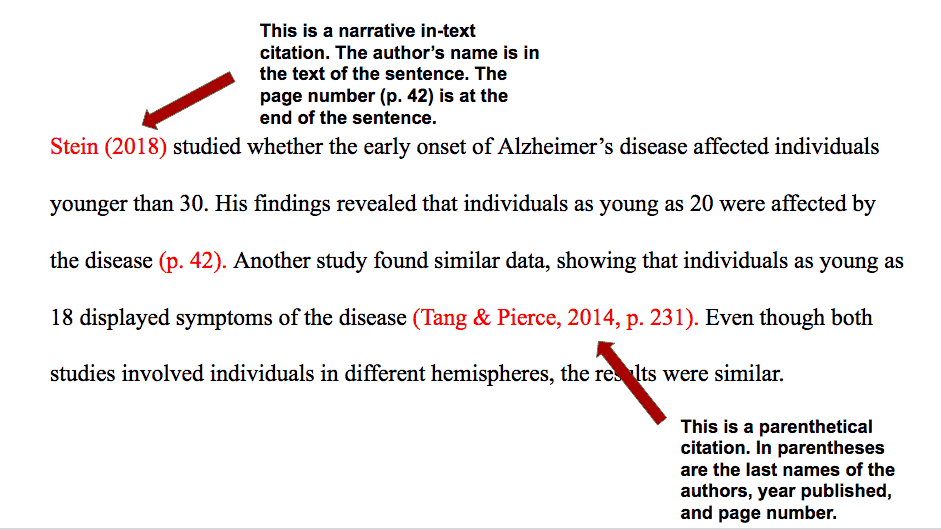
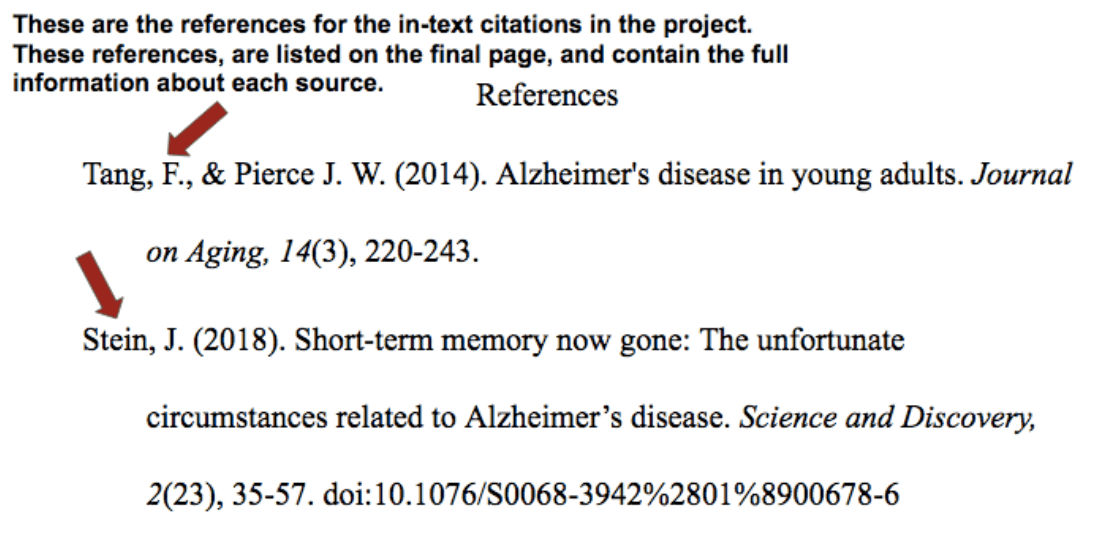
Why is it important to include citations & references
Including APA citations and references in your research projects is a very important component of the research process. When you include citations, you're being a responsible researcher. You're showing readers that you were able to find valuable, high-quality information from other sources, place them into your project where appropriate, all while acknowledging the original authors and their work.
Common ways students and scholars accidentally plagiarize
Believe it or not, there are instances when you could attempt to include in-text and full references in the appropriate places, but still accidentally plagiarize. Here are some common mistakes to be aware of:
Mistake #1 - Misquoting sources: If you plan to use a direct quote, make sure you copy it exactly as is. Sure, you can use part of the full quote or sentence, but if you decide to put quotation marks around any words, those words should match exactly what was found in the original source.
Here's a line from The Little Prince, by Antoine de Saint-Exupéry:
"Grown-ups never understand anything by themselves, and it is tiresome for children to be always and forever explaining things to them."
Here's an acceptable option:
"Grown-ups never understand anything by themselves," stated de Saint-Exupéry (1943, p. 3).
Here's a misquote:
"Grown-ups barely ever understand anything by themselves," stated de Saint-Exupéry (1943, p. 3).
Notice the slight change in the words. The incorrect phrasing is an instance of accidental plagiarism.
Mistake #2 - Problems with paraphrasing: When we paraphrase, we restate information using our own words and writing style. It's not acceptable to substitute words from the original source with synonyms.
Let's use the same sentence from The Little Prince.
A correct paraphrase could be:
de Saint-Exupéry (1943) shares various ways adults frustrate children. One of the biggest being that kids have to explain everything. It's too bad adults are unable to comprehend anything on their own (p. 3).
An incorrect paraphrase would be:
de Saint-Exupéry (1943) shares that adults never understand anything by themselves, and it is exhausting for kids to be always and forever clarifying things to them (p.3).
Notice how close the incorrect paraphrase is from the original. This is an instance of accidental plagiarism.
Make sure you quote and paraphrase properly in order to prevent accidental plagiarism.
If you're having a difficult time paraphrasing properly, it is acceptable to paraphrase part of the text AND use a direct quote. Here's an example:
de Saint-Exupery (1943) shares various ways adults frustrate children. One of the biggest being that kids have to explain everything, and "it is tiresome for children to be always and forever explaining things to them" (p. 3).
Information About APA
Who created it?
The American Psychological Association is an organization created for individuals in the psychology field. With close to 121,000 members, they provide educational opportunities, funding, guidance, and research information for everything psychology-related. They also have numerous high-quality databases, peer-reviewed journals, and books that revolve around mental health.
The American Psychological Association is also credited with creating their own specific citation and reference style. Today, this format is used by individuals not only in the psychology field, but many other subject areas as well. Education, economics, business, and social sciences also use APA style quite frequently. Click here for more information. This guide covers general information about the style, but is not affiliated with the American Psychological Association.
Why was this style created?
This format was first developed in 1929 to form a standardized way for researchers in science fields to document their sources. Prior to the inception of these standards and guidelines, individuals were recognizing the work of other authors by including bits and pieces of information in random order. There wasn't a set way to format citations and references. You can probably imagine how difficult it was to understand the sources that were used for research projects!
Having a standard format for citing sources allows readers to glance at a citation or APA reference and easily locate the title, author, year published, and other critical pieces of information needed to understand a source.
The evolution of this style
The guide below is based on APA style 7th edition, which was released in 2020. In previous versions of APA format, researchers and scholars were required to include the publisher location for books and the date that an electronic resource was accessed. Both are no longer required to be included.
Details on the differences between the 6th and 7th editions is addressed later in this guide.
Citations & References
The appearance of citations & references
The format for references varies, but most use this general format:
Author's Last name, First initial. (Date published). Title. URL
Researchers and scholars must look up the proper format for the source that they're attempting to cite. Books have a certain format, websites have a different format, periodicals have a different format, and so on. Scroll down to find the proper format for the source you're citing or referencing.
If you would like help citing your sources, CitationMachine.com has a citation generator that will help make the APA citation process much easier for you. To start, simply click on the source type you're citing:
- Website
- Books
- Journal articles
- YouTube
- Images
- Moviews
- Interview
- Newspaper
- Magazines
In-text citations
An APA in-text citation is included in research projects in three instances: When using a direct quote, paraphrasing information, or simply referring to a piece of information from another source.
Quite often, researchers and scholars use a small amount of text, word for word, from another source and include it in their own research projects. This is done for many reasons. Sometimes, another author's words are so eloquently written that there isn't a better way to rephrase it yourself. Other times, the author's words can help prove a point or establish an understanding for something in your research project. When using another author's exact words in your research project, include an APA in-text citation directly following it.
In addition to using the exact words from another source and placing them into your project, these citations are also added anytime you paraphrase information. Paraphrasing is when you take information from another source and rephrase it, in your own words.
When simply referring to another piece of information from another source, also include a citation directly following it.
Citations in the text are found near a direct quote, paraphrased information, or next to a mention of another source. To see examples of some narrative/parenthetical citations in action, look at the image above, under "All About Citations & References."
Note: *Only include the page or paragraph number when using a direct quote or paraphrase. Page numbers have a p. before the number, pp. before the page range, and para. before the paragraph number. This information is included to help the reader locate the exact portion of text themselves. It is unnecessary to include this information when you're simply referring to another source.
Examples of APA in-text citations:
"Well, you're about to enter the land of the free and the brave. And I don't know how you got that stamp on your passport. The priest must know someone" (Tóibín, 2009, p. 52).
and
Student teachers who use technology in their lessons tend to continue using technology tools throughout their teaching careers (Kent & Giles, 2017, p. 12).
If including the author's name in the sentence, place the year in the parentheses directly next to his or her name. Add the page number at the end, unless it's a source without any pages or paragraph numbers (See Section 8.10 of the Publication manual for more details).
In-text citation APA example:
According to a study done by Kent and Giles (2017), student teachers who use technology in their lessons tend to continue using technology tools throughout their teaching careers.
The full references, or citations, for these sources can be found on the last part of a research project, titled the "References."
Here's how to create in-text citations for specific amounts of authors:
When the source lacks an author's name, place the title, year, and page number (if available) in the text. The title should be in italics if it sits alone (such as a movie, brochure, or report). If the source is part of a whole (as many web pages and articles are), place the title in quotation marks without italics (See Section 8.14 of the Publication manual).
Structure of an APA format citation in the text narratively, with the author's name missing:
Title of Source (Year) or "Title of Source" (Year)
OR
Structure of an APA style format citation, in parentheses at the end of the sentence, with the author's name missing: (Title of Source, Year) or ("Title of Source," Year)
Structure for one author
In the text, narratively: Last name of Author (Year)...(page number).
OR
In parentheses, at the end of the sentence: (Last name of Author, Year, page number).
Structure for two authors
Place the authors in the order they appear on the source. Only use the ampersand in the parenthetical citations (see Section 8.17 of the Publication manual). Use 'and' to separate the author names if they're in the text of the sentence.
In the text, narratively: Last name of Author 1 and Last name of Author 2 (Year)....(page number).
OR
In parentheses, at the end of the sentence: (Last name of Author 1 & Last name of Author 2, Year, page number).
Structure for three or more authors
Only include the first listed author's name in the first and any subsequent citations. Follow it with et al.
(Last name Author 1 et al., Year, page number)
(Agbayani et al., 2020, p. 99)
OR
Last name of Author 1 et al. (Year)...(page).
Agbayani et al. (2020)...(p. 99)
One author, multiple works, same year
What do you do when you want to cite multiple works by an author, and the sources all written in the same year?
Include the letters 'a' 'b' 'c' and so on after the year in the citation.
(Jackson, 2013a)
OR
Jackson (2013a)
Writers can even lump dates together.
Example: Jackson often studied mammals while in Africa (2013a, 2013b).
On the APA reference page, include the same letters in the full references.
Groups and organizations
Write out the full name of the group or organization in the first citation and place the abbreviation next to it in brackets. If the group or organization is cited again, only include the abbreviation. If it doesn't have an abbreviation associated with it, write out the entire organization's name each and every time (see Section 8.21 of the Publication manual).
Example:
First APA citation for an organization with an abbreviation: (World Health Organization [WHO], Year)
OR
World Health Organization (WHO, Year)
Notice in the example directly above, the name of the organization is written out in full in the text of the sentence, and the abbreviation is placed in parentheses next to it.
Subsequent APA citations in the text for an organization with an abbreviation: (WHO, Year) OR WHO (Year)
Example:
All citations in the text for an organization without an abbreviation: (Citation Machine, Year) or Citation Machine (Year)
One in-text citation, multiple works
Sometimes you'll need to cite more than one work within an in-text citation. Follow the same format (author, year) format but place semicolons between works (p. 263).
Example:
(Obama, 2016; Monroe et al., 1820; Hoover & Coolidge, 1928)
Reminder: There are many citation tools available on CitationMachine.com. Head to our homepage to learn more, check out our APA citation website, and cite your sources easily! The most useful resource on our website? Our APA citation generator, which doesn't just create full references, it's also an APA in-text citation website! It'll do both for you!
Click here to learn more about crediting work.
Reference list citation components
References display the full information for all the citations found in the body of a research project.
Some things to keep in mind when it comes to the references:
- All references sit together on their own page, which is usually the last page(s) of a paper.
- Title the page 'References'
- Place 'References' in the center of the page and bold it. Keep the title in the same font and size as the references. Do not italicize, underline, place the title in quotation marks, or increase the font size.
- The entire page is double spaced.
- All references are listed in alphabetical order by the first word in the reference, which is usually the author's last name. If the source lacks an author, alphabetize the source by the title (ignore A, An, or The)
- All references have a hanging indent, meaning that the second line of text is indented in half an inch. See examples throughout this guide.
- Remember, each and every citation in the text of the paper MUST have a full reference displayed in the reference list. The citations in the text provide the reader with a quick glimpse about the sources used, but the references in the reference list provide the reader with all the information needed to seek out the source themselves.
Learn more about each component of the reference citation and how to format it in the sections that follow. See an APA sample paper reference list at the end of this entire section.
Author's names
The names of authors are written in reverse order. Include the initials for the first and middle names. End this information with a period (see Section 9.8 of the Publication manual).
Format: Last name, F. M.
Example:
- Angelou, M.
- Doyle, A. C.
Two or more authors
When two or more authors work together on a source, write them in the order in which they appear on the source. You can name up to 20 authors in the reference. For sources with 2 to 20 authors, place an ampersand (&) before the final author. Use this format:
Last name, F. M., & Last name, F. M.
OR
Last name, F. M., Last name, F. M., Last name, F. M., Last name, F. M., & Last name, F. M.
Kent, A. G., Giles, R. M., Thorpe, A., Lukes, R., Bever, D. J., & He, Y.
If there are 21 or more authors listed on a source, only include the first 19 authors, add three ellipses, and then add the last author's name.
Roberts, A., Johnson, M. C., Klein, J., Cheng, E. V., Sherman, A., Levin, K. K. , ...Lopez, G. S.
If you plan on using a free APA citation tool, like the one at CitationMachine.com, the names of the authors will format properly for you.
###No authors
If the source lacks an author, place the title in the first position in the reference (Section 9.12 of the Publication manual). When the source's title begins with a number (Such as 101 Dalmatians), place the reference alphabetically as if the number was spelled out. 101 Dalmatians would be placed in the spot where 'One hundred' would go, but keep the numbers in their place.
Additionally, if the title begins with the words 'A', 'An,' or 'The,' ignore these words and place the title alphabetically according to the next word.
See the "Titles" section below for more information on formatting the title of sources.
###Corporate/Organization authors
On an APA reference page, corporate authors are always written out in full. In the text of your paper, you may have some abbreviations (such as UN for United Nations), but in the full references, always include the full names of the corporation or organization (following Section 9.11 of the official Publication manual).
Example:
United Nations. (2019). Libya: $202 million needed to bring life-saving aid to half a million people hit by humanitarian crisis. https://news.un.org/en/story/2019/02/1031981
Publication date & retrieval date
Directly after the author's name is the date the source was published. Include the full date for newspapers and magazine articles, and only the year for journals and all other sources. If no date is found on the source, include the initials, n.d. for "no date."
Newspaper:
Narducci, M. (2017, May 19). City renames part of 11th Street Ed Snider Way to honor Flyers founder. The Philadelphia Inquirer. http://www.philly.com/
If using our APA Citation Machine, our citation generator will add the correct format for you automatically.
Giving a retrieval date is not needed unless the online content is likely to be frequently updated and changed (e.g., encyclopedia article, dictionary entry, Twitter profile, etc.).
Citation Machine [@CiteMachine]. (n.d.). Tweets [Twitter profile]. Twitter. Retrieved October 10, 2019, from https://twitter.com/CiteMachine
Titles
When writing out titles for books, articles, chapters, or other non-periodical sources, only capitalize the first word of the title and the first word of the subtitle. Names of people, places, organizations, and other proper nouns also have the first letter capitalized. For books and reports, italicize the title in the APA citation.
Examples:
Strange case of Dr. Jekyll and Mr. Hyde.
Roots: The saga of an American family.
For articles and chapters in APA referencing, do not italicize the title.
Examples:
Wake up the nation: Public libraries, policy making, and political discourse.
For newspapers, magazines, journals, newsletters, and other periodicals, capitalize the first letter in each word and italicize the title.
Example:
The Seattle Times.
A common question is whether to underline your title or place it in italics or quotation marks in the reference list. Here's a good general rule: When a source sits alone and is not part of a larger whole, place the title in italics. If the source does not sit alone and is part of a larger whole, do not place it in italics.
Books, movies, journals, and television shows are placed in italics since they stand alone. Songs on an album, episodes of television shows, chapters in books, and articles in journals are not placed in italics since they are smaller pieces of larger wholes.
The Citation Machine citation generator will format the title in your citations automatically.
Additional information about the title
If you feel it would be helpful to include additional information about the source type, include a descriptive noun or two in brackets immediately following the title. Capitalize the first letter.
Example:
Kennedy, K., & Molen, G. R. (Producers), & Spielberg, S. (Director). (1993). Jurassic Park [Film]. USA: Universal.
Besides [Film], other common notations include:
- [Audio podcast]
- [Brochure]
- [Letter to the editor]
- [Television series episode]
- [Tweet]
- [Facebook page]
- [Blog post]
- [Lecture notes]
- [PowerPoint presentation]
- [Video file]
If you are using Citation Machine citing tools, additional information about the title is automatically added for you.
Publisher information
For books and reports, include the publisher name but not the location (see Section 9.29 of the Publication manual). Older editions of the style required the city, state and/or country, but this hasn't been the case since the 7th edition was released.
It is not necessary to include the entire name of the publisher. It is acceptable to use a brief, intelligible form. However, if Books or Press are part of the publisher's names, keep these words in the reference. Other common terms, such as Inc., Co., Publishers, and others can be omitted.
For newspapers, journals, magazines, and other periodicals, include the volume and issue number after the title. The volume number is listed first, by itself, in italics. The issue number is in parentheses immediately after it, not italicized. There is no space after the closing parenthesis and before the volume number.
Example:
Giannoukos, G., Besas, G., Hictour, V., & Georgas, T. (2016). A study on the role of computers in adult education. Educational Research and Reviews, 11(9), 907-923. https://doi.org/10.5897/ERR2016.2688
After including the publisher information, end this section with a period.
Examples:
Pearson.
Perseus Books.
Electronic source information:
For online sources, the URL or DOI (Direct Object Identifier) are included at the end of an APA citation.
DOI numbers are often created by publishers for journal articles and other periodical sources. They were created in response to the problem of broken or outdated links and URLs. When a journal article is assigned a DOI number, it is static and will never change. Because of its permanent characteristic, DOIs are the preferred type of electronic information to include in APA citations. When a DOI number is not available, include the source's URL (see Section 9.34 in the Publication manual).
For DOIs, include the number in this format:
http://doi.org/xxxx
For URLs, type them in this format:
http:// or https://
Other information about electronic sources:
- If the URL is longer than a line, break it up before a punctuation mark.
- Do not place a period at the end of the citation/URL.
- It is unnecessary to include retrieval dates, unless the source changes often over time (like in a Wikipedia article).
- It is not necessary to include the names of databases
If using the Citation Machine APA citation website autocite features, the online publication information will be automatically replaced by the DOI. The Citation Machine APA template will properly cite your online sources for you.
Sample - Student Paper Reference Page APA: 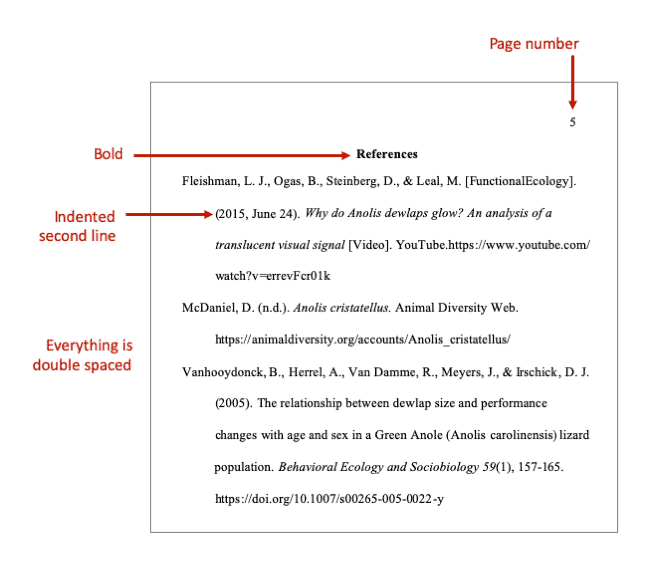
Make sure you run your completed paper through the Citation Machine Plus smart proofreader, which scans for grammar, spelling, and plagiarism. Whether it's an adjective, verb, or pronoun out-of-place, our technology helps edits your paper for you!
Annotated bibliographies:
An APA annotated bibliography is a full bibliography that includes a small note for each reference citation. Each note should be short (1-2 paragraphs) and contain a summary or your evaluation about each source. When creating your citations on CitationMachine.net, there is a field at the bottom of each form to add your own annotations.
Follow the publication manual guidelines on paper format and writing style. Let your instructor guide other details about your annotations. Still confused? Read our guide on annotated bibliographies.
These types of projects look different depending on the style you're using. Use the link at the top of the page to access resources related to the Modern Language Association's style. Here's information related to Chicago citation style.
Page formatting
Need help with the design and formatting of your paper? Look no further! This section provides the ins and outs of properly displaying the information in your APA essay.
- Font = Here are the recommended fonts and sizes (from Section 2.19 of the Publication manual):
- Times New Roman, 12-point size.
- Calibri, Arial, or Georgia, 11-point size
- Lucida, Sans Unicode, or Computer Modern, 10-point size
- Indents = Every paragraph should start with an indent.
- Margins = 1 inch around the entire document
- Spacing = Double space everything!
Arrange your pages in this order:
- Page 1 - APA Title Page (see below for information on the title page)
- Page 2 - Abstract (If your professor requests one)
- Page 3 - First page of text
- References begin on their own page. Include the list of references on the page after the text.
- Tables and figures
Keep in mind that the order above is the recommendation for papers being submitted for peer review. If you're writing an APA style paper for a class, your professor may be more lenient about the requirements. Also, if you're submitting your paper for a specific journal, check the requirements on the journal's website. Each journal has different rules and procedures.
Just a little nudge to remind you about the Citation Machine Plus smart proofreader. Whether it's a conjunction or interjection out of place, a misspelled word, or an out of place citation, we'll offer suggestions for improvement! Don't forget to check out our APA citation maker while you're at it!
Running heads
In older editions of APA, running heads were required for all papers. Since the 7th edition, that's changed.
- Student paper: No running head
- Professional paper: Include a running head
The running head displays the title of the paper and the page number on all pages of the paper. This header is found on every page of a professional paper (not a student paper), even on the title page (sometimes called an APA cover page) and reference list (taken from Section 2.8 of the Publication manual).
It's displayed all in capital letters at the top of the page. Across from the running head, along the right margin, is the page number.
- Use the header feature in your word processor. Both Google Docs and Word have these features available.
- Use one for the recommended fonts mentioned under "Page formatting."
Title pages
A title page, sometimes called an APA cover page, graces the cover of an essay or paper. An APA title page should follow rules from Section 2.3 of the official Publication manual and include:
- Page number, which is page 1
- Title of your project
- Use title case and bold font
- The title should be under 12 words in length
- The title should be a direct explanation of the focus of the paper. Do not include any unnecessary descriptors such as "An Analysis of…" or "A Study of…"
- Names of the authors
- Exclude any labels such as Mr., Ms., Dr, PhD...
- Name of the school or institution
- Course number and/or class name
- Name of your instructor, including their preferred honorifics (e.g., PhD, Dr., etc.)
- Paper's due date
- If this is a professional paper, also include a running head. If this is a student paper, do not include one.
Follow the directions for the running head and page number in the section above. Below the running head, a few lines beneath, and centered in the middle of the page, should be the title. The next line below is the author's name(s), followed by the name of the school or institution, the class or course name, your instructor's name, and the paper's due date.
All components on this page should be written in the same font and size as the rest of your paper. Double space the title, names, name of school or institution, and all other information on the page (except for the running head and page number).
Example - Student Title Page APA:
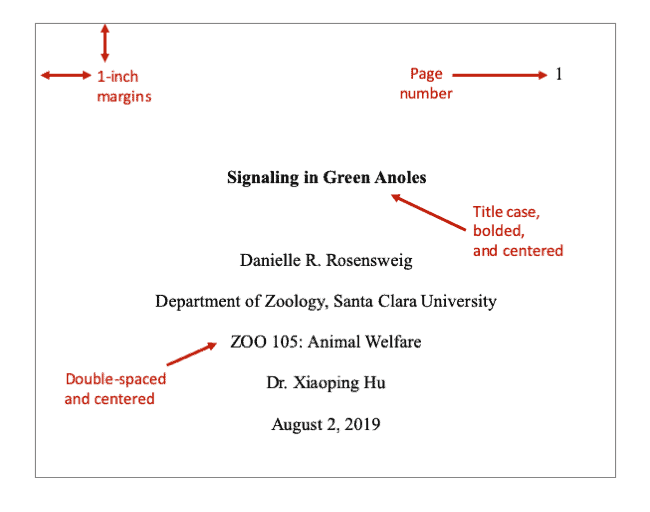
Example - Professional Title Page APA:
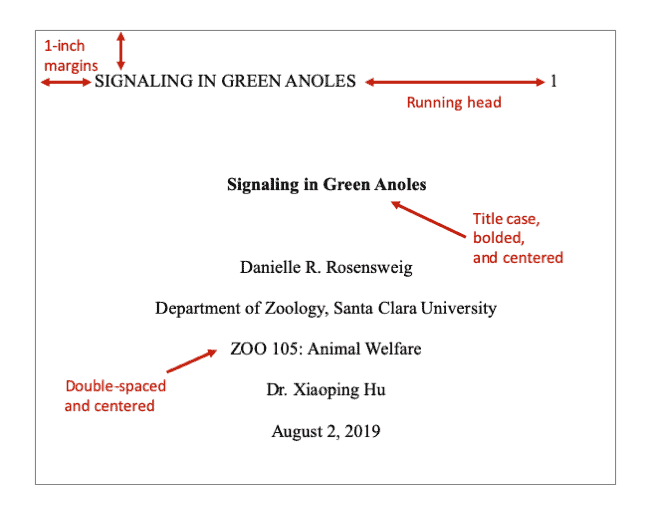
If you're submitting your paper to a journal for publication, check the journal's website for exact requirements. Each journal is different and some may request a different type of APA format cover page.
Looking to create an APA format title page? Head to CitationMachine.com's homepage and choose "Title Page" at the top of the screen.
Abstracts
An abstract briefly but thoroughly summarizes dissertation contents. It's found in the beginning of a professional paper, right after the title page. Abstracts are meant to help readers determine whether to continue reading the entire document. With that in mind, try to craft the lead sentence to entice the reader to continue reading.
Here are a few tips:
- Be factual and keep your opinions out. An abstract should accurately reflect the paper or dissertation and should not involve information or commentary not in the thesis.
- Communicate your main thesis. What was the examined problem or hypothesis? A reader should know this from reading your abstract.
- Keep it brief. Stick to the main points and don't add unnecessary words or facts. It should not exceed 250 words.
- Consider your paper's purpose. It's important to cater your abstract to your paper type and think about what information the target audience for that paper type would want. For example, an empirical article may mention methodology or participant description. A quantitative or qualitative meta-analysis would mention the different variables considered and how information was synthesized.
- Use verbs over noun equivalents, and active voice. Example: "There was research into…" becomes "We researched…"
Formatting guidelines:
- The abstract goes after the title page.
- It should have the same font (size and type) as the rest of the paper.
- It should stick to one page.
- Double-space all page text.
- Center and bold the word "Abstract" at the top of the paper.
- Don't indent the first line of the abstract body. The body should also be in plain text.
- For the keywords, place it on the line after the abstract and indent the first line (but not subsequent lines). The word "Keywords:" is capitalized, italicized, and followed by a colon. The actual keywords are sentence case and in plan font.
- List each keyword one after the other, and separate them by a comma.
- After the last keyword, no ending punctuation is needed.
Example abstract: 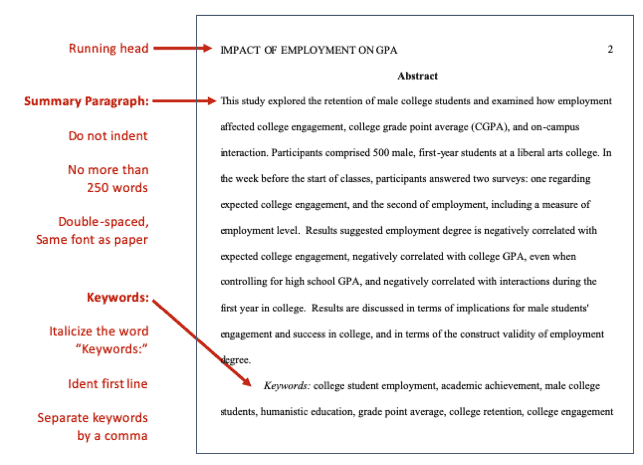
Tables & Figures
If your paper includes a lot of numerical information or data, you may want to consider placing it into a table or a figure, rather than typing it all out. A visual figure or simple, organized table filled with numerical data is often easier for readers to digest and comprehend than tons of paragraphs filled with numbers. Chapter 7 of the Publication manual outlines formatting for tables and figures. Let's cover the basics below.
If you'd like to include a table or figure in your paper, here are a few key pieces of information to keep in mind:
- Either place all tables and figures:
- At the end of the paper after the APA reference page
- In the text after it is first mentioned
- The table first mentioned in the text should be titled 'Table 1.' The next table mentioned in the text is 'Table 2,' and so on. For figures, it would be 'Figure 1,' 'Figure 2,' and so forth.
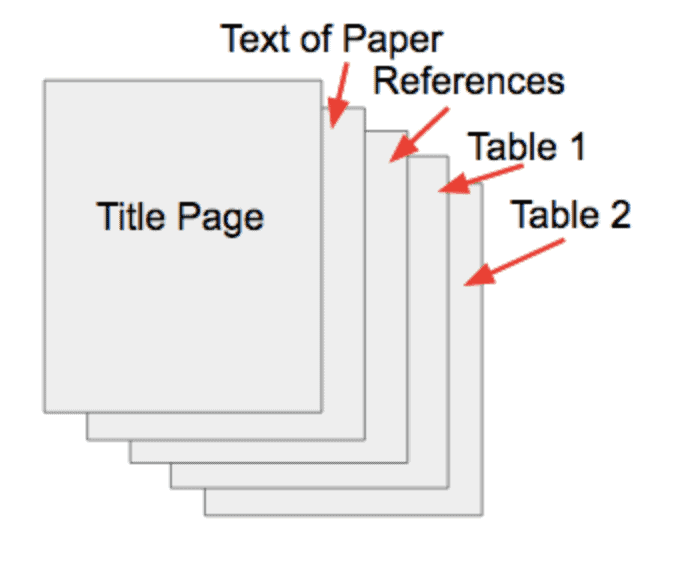
- Even though every table and figure is numbered, also create a title for each that describes the information it contains. Capitalize all important words in the title.
- For tables, do not use any vertical lines, only use horizontal to break up information and headings.
- Single spacing is acceptable to use in tables and figures. If you prefer double spacing your information, that is okay too.
- Do not include extra information or "fluff." Keep it simple!
- Do not include the same exact information in the paper. Only include the complete information in one area—the table or the text.
- All tables and figures must be referenced in the text. It is unacceptable to throw a table or figure into the back of the paper without first providing a brief summary or explanation of its relevance.
Example:
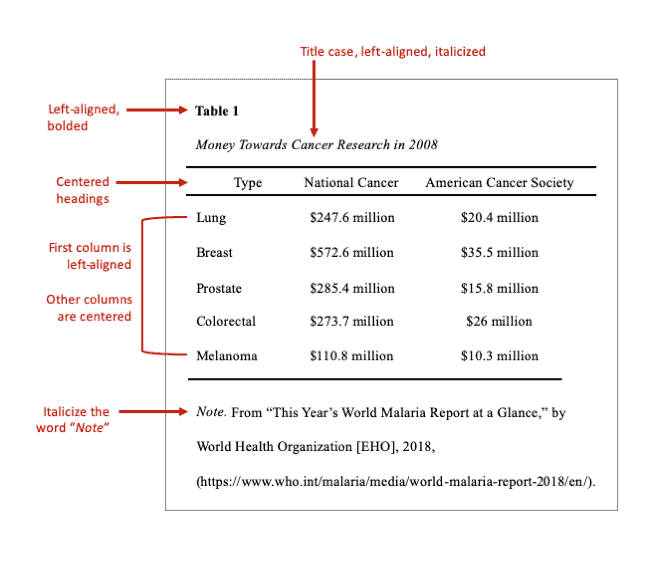
Publication Manual 6th Edition vs 7th Edition
The 6th edition of the Publication Manual of the American Psychological Association was released in 2009. The current 7th edition came out in the fall of 2019 and was designed to be more student focused, provide more guidance on accessibility, and address changes that have developed over the last 10 years.
Below, we've listed what we feel are the most relevant changes related to APA format.
Journals and DOIs
DOI stands for "digital object identifier." Many journal articles use and have a unique DOI that should be included in a full citation.
When including a DOI in a citation, format it as a URL. Do not label it "DOI." Articles without DOIs from databases are treated as print works. For example:
6th edition:
Gänsicke, B. T., Schreiber, M. R., Toloza, O., Fusillo, N. P. G., Koester, D., & Manser, C. J. (2019). Accretion of a giant planet onto a white dwarf star. Nature, 576(7785), 61–64. doi: 10.1038/s41586-019-1789-8
7th edition:
Gänsicke, B. T., Schreiber, M. R., Toloza, O., Fusillo, N. P. G., Koester, D., & Manser, C. J. (2019). Accretion of a giant planet onto a white dwarf star. Nature, 576(7785), 61–64. https://doi.org/10.1038/s41586-019-1789-8
Citing Books
There are few new guidelines when you are citing a book. First, the publisher location no longer needs to be indicated.
6th edition:
Zack, P. O. (2001). The shoals of time. Bloomington, IN: First Books Library.
7th edition:
Zack, P. O. (2001). The shoals of time. First Books Library.
Second, the format of an ebook (e.g., Kindle, etc.) no longer needs to be indicated.
6th edition:
Niven, J. (2012). Ada Blackjack: A true story of survival in the Arctic [Kindle].
7th edition:
Niven, J. (2012). Ada Blackjack: A true story of survival in the Arctic.
Lastly, books from research databases without DOIs are treated the same as print works.
URLs
When using a URL in a citation, you no longer need to include the term "Retrieved from" before URLs (except with retrieval dates). The font should be blue and underlined, or black and not underlined.
6th Edition:
Flood, A. (2019, December 6). Britain has closed almost 800 libraries since 2010, figures show. The Guardian. Retrieved from https://www.theguardian.com/books/2019/dec/06/britain-has-closed-almost-800-libraries-since-2010-figures-show
7th Edition:
Flood, A. (2019, December 6). Britain has closed almost 800 libraries since 2010, figures show. The Guardian. https://www.theguardian.com/books/2019/dec/06/britain-has-closed-almost-800-libraries-since-2010-figures-show
Authors
Within a full APA citation, you may spell out up to 20 author names. For two to 20 authors, include an ampersand (&) before the name of the last author. For sources with 21 or more authors, structure it as follows:
Structure: First 19 authors' names, . . . Last author's name.
7th edition example: Washington, G., Adams, J., Jefferson, T., Madison, J., Monroe, J., Adams, J. Q., Jackson, A., Van Buren, M., Harrison, W. H., Tyler, J., Polk, J. K., Taylor, Z., Filmore, M., Pierce, F., Buchanan, J., Lincoln, A., Johnson, A., Grant, U. S., Hayes, R. B., Garfield, . . . Trump, D.
When creating an in-text citation for a source with 3 or more authors, use "et al." after the first author's name. This helps abbreviate the mention.
6th Edition: (Honda, Johnson, Prosser, Rossi, 2019)
7th Edition: (Honda et al., 2019)
Tables and Figures
Instead of having different formats for tables and figures, both use one standardized format. Now both tables and figures have a number, a title, name of the table/figure, and a note at the bottom.
If you're still typing into Google "how to cite a website APA" among other related questions and keywords, click here for further reading on the style.
When you're through with your writing, toss your entire paper into the Citation Machine Plus plagiarism checker, which will scan your paper for grammar edits and give you up to 5 suggestions cards for free! Worry less about a determiner, preposition, or adverb out of place and focus on your research!
References
American Psychological Association. (2020). Publication manual of the American Psychological Association (7th ed.) (2020). American Psychological Association. https://doi.org/10.1037/0000165-000
Updated March 3, 2020
Written and edited by Michele Kirschenbaum and Wendy Ikemoto. Michele Kirschenbaum has been an awesome school librarian since 2006 and is an expert in citing sources. Wendy Ikemoto has a master's degree in library and information science and has been working for Citation Machine since 2012.
Machine à Pã¢tes Professionnelle électrique Marcato 3 en 1
Source: https://www.citationmachine.net/apa
0 Response to "Machine à Pã¢tes Professionnelle électrique Marcato 3 en 1"
Post a Comment